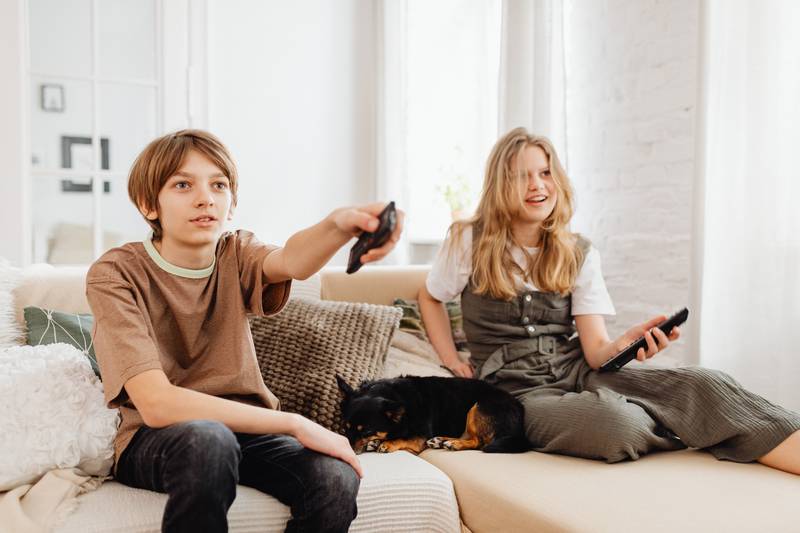How to Stop Dog Chewing TV Remote Control [5 Step Fix!]
Having your dog chew up your TV remote control can be a frustrating problem. If you’re trying to figure out how to stop your dog from doing this, you’ve come to the right place.
This article will help you understand why dogs are attracted to remotes in the first place and give you some strategies to discourage this behavior. We’ll also discuss how to keep your remotes safe when you’re not home, if certain smells can deter dogs, and how to deal with the aftermath of a chewed-up remote.
What if it was a puppy who did the chewing? Don’t worry, we have some puppy-specific advice too. Read all this below in our article “How to Stop Dog Chewing TV Remote Control.”
Dog Chewed Remote: How to Stop

To stop your dog chewing on the remote control:
- Keep the TV remote hidden away or as out of reach as possible while also using a protective cover for it.
- Make sure your dog always has available an acceptable outlet for their chewing such as a toy that can keep them busy.
- Spray something to deter them, like a 50/50 solution of distilled white vinegar and water onto a cloth and wipe down the remote control with it. The smell of vinegar will be gone after sixty minutes, but your dog will continue to be repelled.
- Give a firm but calm “stop” or “no” right away when you notice your dog is once again chewing the TV remote. Don’t scream or get mad, because if they’re misbehaving like this due to anxiety (a likely explanation), this will only make their worries worse.
- If you observe your dog beginning to go towards the TV remote again, redirect their attention to a favorite toy. Give them pets, praise, and a small treat when they choose their toy instead of chewing on the TV remote. Be sure that anyone else who lives in your home is also following these instructions. Be patient and consistent.
These steps will get your dog to stop chewing the TV remote, but it’s important to remember that the underlying behavioral issues (anxiety, boredom, attention-seeking) that were causing all of this to begin with will still be present. And until you address those, any positive changes you see are only going to be temporary.
“Well, how do I make these changes last?”
By getting your dog to truly choose to follow your direction, that’s how. I tried many times to write out how you can do that before deciding it made more sense to just link you to the free video series that explains it better than I’d ever be able to.
The series is by a man named Dan who is one of the world’s leading dog obedience trainers. In it, he teaches you how to put an end to things like when your dog chews the remote control and all other misbehavior using his fast and easy-to-follow methods.
In the first video, Dan will reveal to you why the two most common methods of dog training only doom you to failure. You can watch the video now by clicking here. Follow the proven system he’ll show you in his series and you’ll never have to spend another second worrying about your dog chewing the television remote ever again!
Why Do Dogs Chew Remotes?

If your dog has taken a liking to chewing your remote controls, you might be wondering why. It can be puzzling, frustrating, and, of course, damaging to your electronics. Understanding why your dog is doing this is the first step towards stopping the behavior.
Anxiety
Some dogs may chew objects like remotes when they’re anxious or stressed. It could be separation anxiety or a reaction to a change in their environment. Chewing can be a self-soothing behavior for them. They may also be chewing on your glasses, chewing on wires, or chewing on your phone charger.
Boredom
Dogs, especially high-energy breeds, need physical and mental stimulation. If they aren’t provided with enough activities or toys, they may turn to chewing household items like remotes.
Curiosity
Dogs are naturally curious creatures. They explore the world with their mouths. To a dog, a remote control is an interesting object with buttons and moving parts, and it carries the scent of their favorite human. This can make it irresistible to chew.
Teething
Puppies go through a teething process, much like human babies. During this time, they have a natural instinct to chew to alleviate the discomfort. If a remote is left within their reach, it may end up being their chew toy.
In conclusion, while it’s normal for dogs to chew, they should be discouraged from chewing inappropriate items like remotes. Providing suitable chew toys, ensuring they get enough exercise, and addressing any underlying anxiety issues (learn how to do that in the first section) can help prevent this behavior.
Dog Keeps Chewing Remotes When I’m Not Home
It can be quite a surprise to return home and find your remote control in pieces, courtesy of your furry friend. If your dog keeps chewing remotes when you’re not home, there could be several reasons behind this behavior.
- Boredom: One of the main culprits is often boredom. Dogs are social animals and they need mental and physical stimulation. When they’re alone at home, they might not be getting enough of either. The remote control, with its interesting buttons and textures, can make a compelling chew toy for a bored dog.
- Your Scent: Another reason could be that your remote control carries your scent. We often underestimate just how sensitive a dog’s nose is. They can pick up scents we aren’t even aware of. Since you handle the remote often, it smells like you. Your dog might be chewing it as a way to feel closer to you when you’re not home.
- Desire for Attention: Sometimes, dogs learn to associate certain behaviors with getting attention. If they’ve noticed that chewing the remote gets a reaction from you, they might be repeating the behavior for attention, even if it’s negative attention.
- Teething: If your pet is a young puppy, the remote chewing might be a sign of teething. Puppies go through a teething phase where they’ll chew on almost anything to soothe their gums.
It’s important to remember that dogs don’t engage in destructive behavior like this out of spite or malice. They’re simply trying to communicate a need or feeling. Instead of punishing them, consider providing more chew toys or interactive games to keep them busy while you’re away.
Also, make sure to put away items you don’t want chewed. In the end, if this behavior becomes a persistent problem, then on top of teaching your dog to not destructively chew on things, you also need to help them with the underlying issue. We went over how to do both in the first section.
Dog Chewing Remote Control: Smell Deterrents?
When your dog has developed a liking for chewing your remote control, it’s time to consider what measures can be taken. One popular approach to stop this gnawing habit is through smell deterrents.
- Commercial Deterrent Sprays: Numerous sprays are available on the market designed to deter dogs from chewing. They work by emitting a smell and taste that dogs find unpleasant. While harmless, the unpleasant experience will often discourage them from chewing your remote control.
- Homemade Deterrents: If you prefer a DIY approach, you can make your own smell deterrent at home. A 50/50 mixture of distilled white vinegar and water can serve this purpose. The smell will go away after about an hour but your dog will still be repelled.
- Citrus Peels: Dogs generally dislike the smell of citrus. Placing citrus peels near the area where you store the remote can help to discourage your dog from going near it. Be cautious, though, certain citrus fruits like lemons and grapefruits can be harmful to dogs if ingested.
- Menthol: Another smell that dogs tend to dislike is menthol, which you can find in certain sprays and oils. Again, be careful about the product’s potential impact on the remote control’s material.
Remember, these smell deterrents are a temporary solution. While they can discourage your dog from chewing the remote, it’s important to address the underlying issue causing this behavior, which we went over how to do in the first section of this article.
Dog Chewed TV Remote: Can It Be Fixed & Can I Still Use It?
When your dog chewed your TV remote, it can be a real headache. Questions quickly arise: can it be fixed, and can it still be used in its current state? Let’s answer those below.
Assessing the Damage
The first thing to do when your dog has chewed your TV remote is to assess the extent of the damage. Check for missing buttons, visible electronic components, or any areas that have been gnawed through completely.
Can It Be Fixed?
Whether or not a chewed remote can be fixed depends largely on the severity of the damage. If it’s just superficial—meaning your dog has left teeth marks but hasn’t managed to actually break through the plastic—then it may still function normally. If the chewed area includes buttons, you may be able to replace them if you can find the right parts.
Can I Still Use It?
As for whether you can still use a chewed remote, the answer is possibly. If the internal circuitry hasn’t been damaged, and the buttons can still be pressed, it may continue to work. However, using a damaged remote could be unsafe if there are exposed electronic components.
Replacement May Be Necessary
If the damage is too severe, you may need to replace the remote. Many manufacturers sell replacement remotes, and universal remotes are also an option.
In conclusion, a chewed TV remote can sometimes be fixed and used, but safety should always be the top priority. Be sure to inspect the remote thoroughly before attempting to use it again. To prevent future incidents, keep remotes out of your dog’s reach, provide suitable chew toys, and (most importantly) address the underlying problem.
Dog Ate TV Remote Control: What Should I Do?
If your dog ate the TV remote control and you need to know what to do next, here are the steps to follow:
- Stay calm: It’s important to stay calm and avoid panicking. While it’s not ideal for your dog to ingest foreign objects, getting stressed or upset won’t help the situation.
- Assess the situation: Determine if your dog has only chewed on the remote or if they have actually swallowed any parts of it. If your dog has ingested any pieces, it’s essential to take appropriate action.
- Contact your veterinarian: If your dog has swallowed any parts of the TV remote control, it’s crucial to contact your veterinarian immediately. They can provide guidance based on the size of your dog, the materials ingested, and any potential risks.
- Monitor your dog: Keep a close eye on your dog for any signs of distress, such as vomiting, gagging, difficulty breathing, or abdominal pain. If you notice any concerning symptoms, contact your veterinarian right away.
- Follow your veterinarian’s advice: Your veterinarian may recommend monitoring your dog at home, inducing vomiting if it’s safe to do so, or bringing your dog in for an examination. It’s important to follow their guidance to ensure the well-being of your furry friend.
- Prevent future incidents: Take steps to prevent your dog from accessing items like remote controls by keeping them out of reach. Use designated dog-proof storage areas or consider using pet gates to restrict access to certain areas of your home. Address the underlying behavioral problem, which we went over this in the first section.
Remember, every situation is unique, and the appropriate steps to take may vary based on your dog’s size, the materials ingested, and the advice of your veterinarian. It’s always recommended to seek professional guidance to ensure the health and safety of your dog.
How to Protect Remote Control From Dog
If your dog has a habit of chewing on remote controls and you want to prevent further incidents, here are some steps you can take to protect your remote control:
- Store the remote control out of reach: Keep the remote control in a secure and elevated location where your dog can’t access it. Consider using a shelf, drawer, or a remote control holder that is placed high enough to prevent your dog from reaching it.
- Use deterrent sprays: Apply a pet-safe deterrent spray to the remote control. These sprays usually have a bitter taste that dogs dislike, which can discourage them from chewing on the remote control. Follow the instructions on the spray bottle and reapply as needed.
- Provide appropriate chew toys: Make sure your dog has access to plenty of appropriate chew toys. Providing toys specifically designed for chewing can redirect their chewing behavior away from the remote control. Rotate the toys regularly to keep them interesting for your dog.
- Supervise your dog: Keep a close eye on your dog when they are around the remote control. If you notice them showing interest or attempting to chew on it, redirect their attention to a more appropriate chew toy. Offer praise and rewards when they engage with the toy instead.
- Training and obedience commands: Teach your dog basic obedience commands such as “leave it” or “drop it.” These commands can be useful in redirecting their attention away from the remote control when needed. Practice these commands during training sessions and reinforce them with positive rewards.
- Use remote control covers: Consider using remote control covers or cases specifically designed to protect your remote control from damage. These covers can provide a physical barrier and make the remote control less appealing to your dog.
By following these steps and implementing preventive measures, you can help protect your remote control from your dog’s chewing tendencies and minimize the risk of damage. Remember to always provide alternative outlets for your dog’s chewing needs and to treat the underlying behavioral issue through training and rewards.
Puppy Chewing Remote: Do I Handle Differently?
When you puppy’s chewing on the remote, it might leave you wondering: should this situation be handled differently compared to an adult dog? The answer is yes, there are specific ways to approach this issue with puppies.
Why Puppies Chew
Understanding why puppies chew is the first step in addressing the issue. Puppies chew as a way to explore their surroundings, relieve teething discomfort, and deal with boredom or anxiety. Teething, in particular, is a phase that all puppies go through, and it can cause them to chew on inappropriate items, like a remote control.
Training Puppies Not to Chew Remotes
Training is a key component when dealing with a puppy chewing on remotes. When you catch your puppy in the act, redirect them to an appropriate chew toy. This helps them learn what they are and are not allowed to chew. Be sure to praise your puppy when they chew on the right things.
Keep Remotes Out of Reach
Because puppies are naturally curious and love to chew, it’s important to keep remotes out of their reach whenever possible. This helps to prevent them from developing a habit of chewing on these items.
Puppy-Proof Your Home
A great preventative measure is to puppy-proof your home. This includes removing or securing any items that your puppy may be tempted to chew on, including remotes.
Provide Suitable Chew Toys
Lastly, providing your puppy with plenty of appropriate chew toys is vital. This gives them an outlet for their chewing needs and keeps them from targeting your belongings.
In summary, while it’s a similar approach to handling an adult dog, understanding your puppy’s specific needs and motivations can help you effectively curb their remote-chewing habit. Consistent training, preventative measures, and suitable alternatives are key in this process. Learn a 5-step process to stop chewing in the first section.
I’m sure you’re looking forward to using a fully-functioning TV remote free of slobber and bite marks, so I’ll let you get started on things now. Good luck, and thank you for reading our article “How to Get Your Dog to Stop Chewing TV Remote.”





